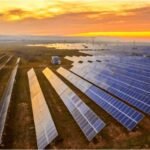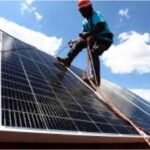Introduction to DIY Solar Power
The trend of DIY solar power installations has gained significant momentum in recent years as more individuals seek to harness renewable energy for their homes. This shift is driven by heightened awareness of environmental sustainability and the escalating costs of traditional energy sources. By opting for solar power, homeowners can significantly reduce their utility bills while contributing to the reduction of carbon footprints, which positively impacts the environment.
A critical factor propelling this movement is the decreasing cost of solar technology, which has made solar panels more accessible to the average consumer. As prices continue to fall, many homeowners find themselves motivated to adopt DIY methods for installing solar systems. The benefits of DIY solar power go beyond just financial savings; they also offer a sense of empowerment as individuals take control of their energy sources. Such installations can lead to long-term energy independence and resilience against fluctuating electricity prices.
However, the DIY approach to solar energy is not without its limitations. While many components of solar power systems, such as mounting panels or connecting batteries, can be accomplished by skilled DIYers, certain aspects require professional expertise to ensure safety and compliance with local regulations. Improper installations may lead to system inefficiencies or even hazardous conditions. Therefore, it is essential to recognize which elements are appropriate for DIY projects and which should be addressed by certified professionals.
In this blog post, we will delve deeper into the feasible aspects of DIY solar installations, as well as the critical considerations that necessitate professional involvement. Understanding these distinctions can help homeowners make informed decisions as they embark on their solar power journeys.
Understanding Solar Power Systems
Solar power systems harness energy from the sun to generate electricity, providing a renewable and sustainable energy solution. A fundamental understanding of these systems is essential for any homeowner or DIY enthusiast considering a solar project. Primarily, a typical solar energy setup comprises several key components, each playing a vital role in the overall functionality.
The most visible components are the solar panels, which capture sunlight and convert it into direct current (DC) electricity. These panels, usually made of silicon photovoltaic cells, are installed on rooftops or in open areas to maximize sunlight exposure. The efficiency and effectiveness of these panels are critical factors, as they directly influence the amount of electricity generated. It is pertinent to select high-quality solar panels to ensure optimal performance.
Another critical element is the inverter, which plays a key role in converting the DC electricity produced by the solar panels into alternating current (AC) electricity, the type commonly used in homes and businesses. There are different types of inverters, including string inverters, microinverters, and power optimizers, each with its advantages and preferred applications. Understanding the functions and capabilities of each inverter type can significantly affect the efficiency of a solar power system.
Batteries also form an integral part of solar energy systems, particularly for those seeking autonomy from the grid. Energy storage allows for the utilization of solar energy during non-sunny periods, thereby enhancing reliability. Choosing the right battery technology, such as lead-acid or lithium-ion, can be pivotal in managing energy effectively and ensuring long-term service.
Finally, the mounting equipment is essential for securely positioning the solar panels. Effective mounting solutions can influence the inclination and orientation of the panels, which are vital for optimizing solar energy capture. Understanding these components will provide a solid foundation, guiding homeowners on which aspects they can tackle themselves and which require professional expertise.
What You Can Do Yourself: DIY Tasks
As the interest in renewable energy sources grows, many homeowners are looking into solar power as a viable option. Through various DIY tasks, individuals can contribute to their energy solutions without needing extensive professional intervention. This section discusses practical solar power tasks that most DIY enthusiasts can confidently undertake.
One of the first and most crucial stages is planning the layout of solar panels. It involves assessing roof space and orientation toward the sun, which can significantly affect the system’s efficiency. Homeowners can create schematics or use online tools to determine the ideal placement, taking care to avoid potential obstructions like trees or chimneys. Proper planning can lead to maximum energy capture and functionality.
Basic installation is another area where DIYers can make a contribution. Tasks can include securely mounting solar panel brackets on the roof or constructing a ground-based system, depending on individual circumstances. While handling electrical connections should typically be left to professionals, the physical installation of mounts and frames can often be managed by oneself with basic tools.
Conducting site assessments is also something that DIY enthusiasts can excel at. This involves taking measurements, such as roof pitch and sunlight availability throughout the day. These assessments not only inform the ideal panel layout but also help in determining the overall energy needs of the household.
Finally, ongoing maintenance of solar panels falls within the DIY realm. Regular cleaning and visual inspections can help prevent significant issues and ensure that the system operates efficiently. This could include removing debris, checking for shading, and monitoring performance through available apps or inverters.
By engaging in these tasks, homeowners can effectively contribute to their solar power systems, enhance their understanding of renewable energy technology, and ultimately, benefit from the cost savings associated with lower energy bills.
What You Can’t Do Yourself: Professional Tasks
While the allure of DIY solar power installation is strong, particularly for those seeking cost savings and a sense of accomplishment, certain tasks categorically require the expertise of licensed professionals. These specialist areas include but are not limited to electrical connections, solar panel wiring, and adherence to local building codes and regulations. Attempting these complex tasks without adequate training can lead to significant safety hazards, as well as potentially costly mistakes.
One of the most critical aspects of solar power installation is electrical work. Handling electrical components without the proper knowledge can result in severe injuries or even fatalities. Licensed electricians are trained to manage high-voltage systems safely. They understand the nuances associated with different solar panel configurations and the corresponding electrical requirements. Moreover, improper connections can lead to system failures, which require expensive repairs.
Compliance with local building codes is another essential consideration. Every region has specific laws and guidelines governing the installation of solar panels and related equipment. These regulations ensure not only the safety but also the efficacy of the system being installed. A professional is adept at navigating these regulations and can secure the necessary permits, ensuring that the installation is above board and reducing the risk of future liabilities.
Ignoring these professional tasks may result in improper installations where panels are not optimally positioned. Such errors can lead to decreased energy output, negating the initial benefits of installation. Furthermore, many warranties for solar systems can be rendered void if the installation does not comply with established manufacturer guidelines, underscoring the importance of engaging licensed professionals. The financial implications of these errors can far exceed the costs associated with hiring skilled technicians.
Safety Considerations in DIY Solar Projects
When embarking on DIY solar projects, safety must be a paramount concern. Working with solar power systems involves several risks, primarily associated with electrical work. The incorrect handling of electrical components can lead to severe injuries or property damage. It is vital to have a sound understanding of electrical systems and to follow the manufacturer’s recommendations. Before beginning any project, ensure that you turn off all electricity supply to avoid unexpected shocks while working with wiring or connectors.
Proper use of tools is another critical aspect of safety during DIY solar projects. Utilizing tools incorrectly can result in accidents and injuries. Always read the instructions for each tool and ensure that you are familiar with their correct operation. Maintain your tools in good condition to prevent malfunctions. It is essential to use insulated tools especially when working with electrical parts, as they provide an extra layer of protection against electrical shocks.
Personal Protective Equipment (PPE) plays a significant role in ensuring safety when handling solar power systems. Essential protective gear such as gloves, safety goggles, and hard hats should always be worn. The risk of falling when installing solar panels on rooftops necessitates the use of fall protection equipment, including harnesses and secure ladders. In addition to wearing PPE, it is crucial to keep a well-stocked first-aid kit readily available. Familiarize yourself with its contents and basic first-aid procedures, as quick response can significantly mitigate the impact of an injury.
Moreover, knowing emergency procedures beforehand can make a difference in critical situations. Establish a clear plan for addressing accidents or equipment failures, including emergency contacts and steps to take in case of electrical fires. By prioritizing safety through careful planning and preparation, DIY enthusiasts can reduce risks significantly while maximizing the effectiveness of their solar power installations.
Permitting and Regulations
When embarking on a DIY solar power project, understanding local and federal regulations is paramount. Navigating the permitting landscape can often prove complex, yet it is a necessary step to ensure compliance and to avoid potential fines or setbacks that could delay your project. Each jurisdiction may have specific rules governing solar installations, which can include zoning laws, building codes, and environmental regulations. Therefore, familiarizing yourself with these requirements is the first step in any DIY solar endeavor.
To begin, it is advisable to contact your local building department or municipal planning office. They can provide pertinent information regarding what permits are required for solar installations in your area. Often, local governments have guidelines in place that dictate the installation process, including structural evaluations, electrical inspections, and system compatibility with existing infrastructure. Understanding these regulations will help streamline your project and ensure it adheres to safety standards.
Additionally, some regions may also require approval from homeowners’ associations or neighborhood covenants, which may have specific stipulations related to the appearance and placement of solar panels. Failure to obtain the necessary permissions might result in costly modifications or even forced removal of the installed system.
On a broader scale, it’s essential to stay informed about federal regulations as well, especially concerning incentives and tax credits available for solar power systems. The Federal Solar Investment Tax Credit (ITC) allows you to deduct a percentage of the installation costs from your federal taxes, but certain conditions must be met to qualify. Ensuring that all local and federal guidelines are followed not only helps in the successful execution of your DIY solar project but also fosters a more sustainable future.
Budgeting for Your DIY Solar Power Project
When embarking on a DIY solar power project, careful budgeting is essential to ensure that the initiative remains both economically viable and practical. The first step in this financial planning process involves estimating the costs associated with materials, tools, and any necessary permits. The solar panels themselves typically represent a significant portion of the budget, so it is advisable to research various types and brands to find a suitable option that aligns with your financial requirements. Additionally, include the prices of other components such as inverters, mounting hardware, and batteries, if applicable.
In your budgeting process, don’t forget to factor in the tools required for installation. Some DIY solar projects may necessitate specialized equipment, such as a multimeter or a torque wrench, which may not be present in your toolkit. Investigating rental options or borrowing tools from friends or family can help mitigate these costs significantly.
Another critical aspect of your budget should be the permits. Depending on your location, certain local regulations may require specific permits for installation of solar systems. It is crucial to research these requirements in advance and include any associated fees in your budget. Navigating through the initial costs can be daunting; however, DIY solar power projects can lead to significant savings on labor costs, encouraging individuals to consider this investment.
When it comes to sourcing materials, explore various suppliers to identify cost-effective options. Local solar distributors, online marketplaces, and community groups can often provide valuable insights. Additionally, governments and organizations frequently offer financing options or rebates for solar projects, which can further alleviate upfront expenses. Taking advantage of these resources can enhance the affordability and viability of your DIY solar power initiative.
Troubleshooting Common Issues
When engaging in DIY solar panel installations, it is essential to be prepared for potential issues that may arise. Understanding common problems and their solutions can help ensure the smooth operation of your solar energy system. One of the first aspects to consider is panel positioning. If your solar panels are not receiving adequate sunlight, it could be due to improper alignment or shading from nearby trees or structures. Regularly assess the panel orientation and adjust their angle to maximize exposure to sunlight throughout the day.
Another area where DIY solar enthusiasts often encounter difficulties is with wiring. A common issue is loose connections, which can lead to energy losses or even system failure. To troubleshoot, conduct a visual inspection of all wiring, ensuring that connections are tight and free from corrosion. It may be beneficial to use a multimeter to check for continuity and voltage output. If discrepancies are found, consider consulting installation guides or online resources for further assistance.
Inverter failures are also a concern in DIY solar systems. If you notice that your inverter is not functioning correctly—indicated by error messages or lights—it is critical to verify that it is properly connected and configured. Refer to the manufacturer’s instructions for troubleshooting steps specific to your model. Continuously monitoring inverter performance can help preempt issues and maintain the efficiency of the solar power system.
Lastly, regular maintenance routines are vital for preserving the longevity and effectiveness of your solar installation. Regularly clean the solar panels to remove dirt and debris which can block sunlight. Additionally, checking for physical damage or wear on components can prevent surprise failures. By implementing these troubleshooting strategies, DIY solar enthusiasts will be better equipped to manage common installation challenges effectively.
Conclusion: Assessing Your DIY Solar Power Journey
As we conclude our examination of DIY solar power, it is essential to reflect on the knowledge and insights that have been shared throughout this discussion. Engaging in a DIY solar project can be an empowering experience, providing a sense of autonomy and the opportunity to contribute to a more sustainable future. However, it is crucial for individuals to assess their capabilities and resources before embarking on such an endeavor.
When considering a DIY solar energy installation, understanding your skill level and the complexity of the tasks involved is paramount. Not every homeowner possesses the technical proficiency required for advanced electrical or structural work, which could pose risks both to the safety of the installer and to the integrity of the installation itself. Therefore, it is wise to evaluate whether your abilities align with the demands of the project.
Moreover, researching local regulations and permitting requirements is critical. Some aspects of solar installation may be subject to local codes, which could necessitate professional involvement. If uncertainties arise regarding compliance or technical execution, consulting with a qualified solar professional can provide clarity and ease concerns, ensuring that the installation adheres to safety standards.
In summary, successfully transitioning to solar energy can yield substantial long-term benefits, including reduced electricity costs and decreased carbon footprint. As you embark on your DIY solar journey, carefully consider the balance between do-it-yourself efforts and professional assistance. By weighing your options judiciously, you can create a practical and effective solar power solution that aligns with your goals and resources.


